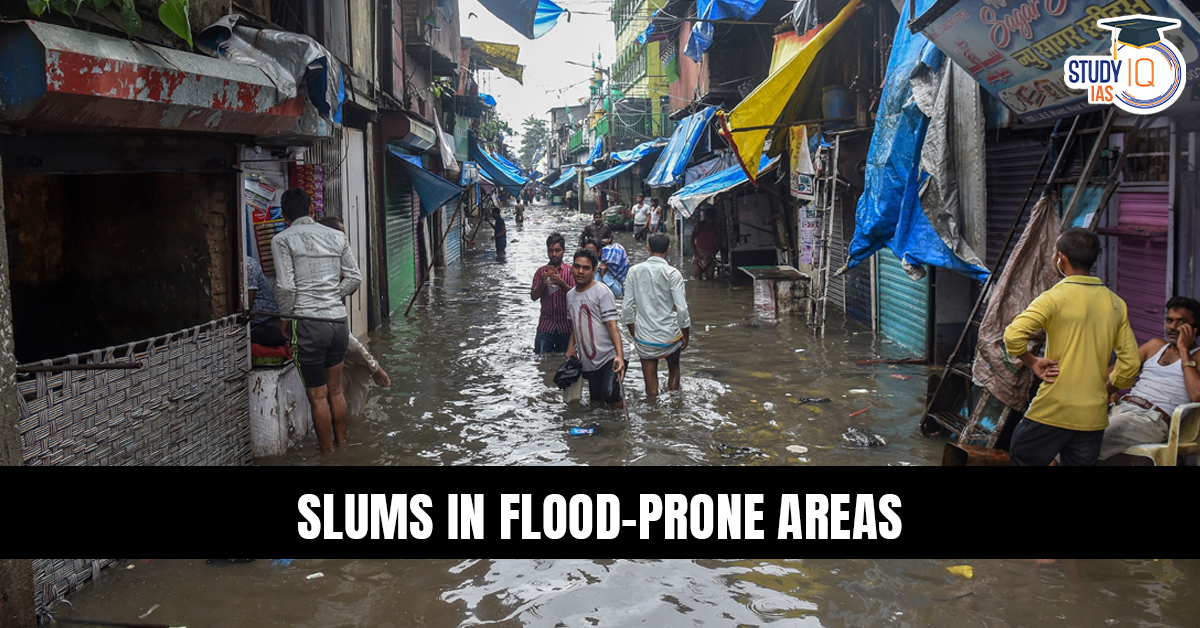Table of Contents
Context: India has the world’s highest number of slum clusters in flood-prone areas.
Key Issues for Slums in Flood Prone Areas
- High Exposure to Flood Risk: Over 158 million slum dwellers in India live in floodplains, especially in the Ganga delta.
- Slum settlements are 32% more likely to be located in flood-prone areas due to cheaper land.
- Lack of Comprehensive Data: In the Global South, including India, there is a scarcity of accurate data on flood exposure for vulnerable communities.
- Unplanned Urban Expansion: Cities are expanding into high-risk flood zones without adequate risk assessments or planning regulations.
- Socioeconomic Vulnerability: People settle in such areas due to job access, poverty, and lack of affordable housing.
- These settlements often have limited education, no flood insurance, and inadequate services.
- Poor Infrastructure: Basic infrastructure like drainage, sanitation, and solid housing is lacking, worsening the impact of floods.
- Informal housing (tin sheets, tarps) is fragile and temporary.
- Inequitable Urban Development: Real estate pressures and gentrification push the poor into riskier zones.
- Builders avoid flood zones, which are then occupied by migrant workers and the urban poor.
Impacts of Floods on Slum Dwellers
- Direct Impacts: Loss of shelter, belongings, and lives during floods.
- Damage to fragile housing in informal settlements.
- Indirect Impacts: Loss of jobs, access to education, health services, and other essential services.
- Increased risk of diseases due to poor sanitation and water stagnation.
- The cycle of poverty worsens with repeated flooding events.
- Social and Institutional Marginalisation: Limited access to disaster preparedness, relief, and recovery measures.
- Exclusion from insurance schemes and climate resilience planning.
Possible Solutions for Slum Dwellers
- Policy & Planning Measures:
- Integrate Slums into Urban Flood Risk Management: Recognise informal settlements in official planning maps.
- Include them in early warning systems and relief programs.
- Implement Human-Centric Development: Shift focus from just flood-prone “locations” to people’s vulnerability.
- Create inclusive infrastructure plans addressing the unique needs of the urban poor.
- Affordable and Resilient Housing: Promote flood-resilient construction and affordable housing schemes in safer areas.
- Integrate Slums into Urban Flood Risk Management: Recognise informal settlements in official planning maps.
- Local Collaboration & Empowerment: Work with slum communities to co-create disaster response strategies.
- Encourage community-led infrastructure improvements, like local drainage or waste management.
- Skill Development and Employment: Generate jobs in sanitation, drainage construction, solid waste management, which also build flood resilience.
- Technological and Data-Driven Solutions: Leverage machine learning on satellite data to map risk-prone zones and track slum expansion over time.
- Use this data for better urban planning and targeted interventions.


 Places in News for UPSC 2026 for Prelims...
Places in News for UPSC 2026 for Prelims...
 Lake Natron: Location, Features, Wildlif...
Lake Natron: Location, Features, Wildlif...
 Erra Matti Dibbalu Added to UNESCO Tenta...
Erra Matti Dibbalu Added to UNESCO Tenta...

























